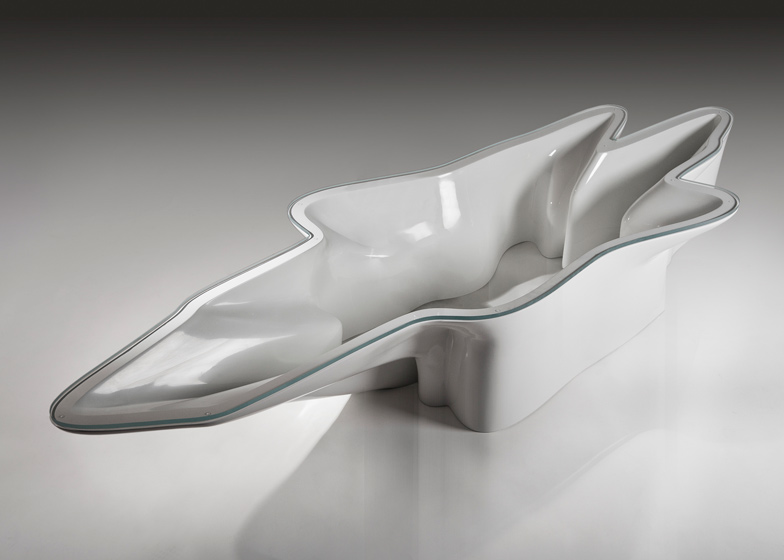Milan 2013: a map of genetic code generated the forms of a table and sculpture on show at Dutch studio Tjep.'s stand at Ventura Lambrate in Milan.
Produced with Netherlands-based company Dutch DNA, Tjep. has utilised gene mapping to create patterns that can be manipulated with specially designed software, producing forms that can be translated into furniture pieces.
To create the DNA map, a sample was taken from the saliva of Dutch contemporary dancer Giulia Wolthuis, whose father Eric founded Dutch DNA. "The process starts with a simple and very established genetic profiling test, the same that's used by the police or in parental tests," Tjep. founder Frank Tjepkema told Dezeen.
Analysis completed at a laboratory in Holland is fed into a program that charts the data, then the lines are built up into 3D forms. "The mapping process is based on a designated design map that we put together ourselves," said Tjepkema. "We map the unique genetic markers, which are essentially numbers, against design points and then can use a range of modelling tools to visualise the patterns and create the final forms."
As everyone's DNA is unique, the patterns created by mapping the genes of individuals will each be slightly different and could be used to create personal furniture pieces. Wolthuis' sample was used for the sculptural glass-topped Darwin table, which was milled on a CNC router, and the Torus sculpture, which was 3D printed from resin. Both pieces are finished in lacquer: the table in white and the sculpture in pink.
Tjep. is also showing a dining booth inspired by old train compartments and a chair with legs like ice skates at Ventura Lambrate, which continues until Sunday.
See more designs by Tjep. »
See all our coverage of Milan 2013 »
See our Milan 2013 map »
Read on for more information from Tjep.:
Tjep. introduces DutchDNA and the world’s first DNA driven furniture designs.
Dutch design house Tjep. introduces Dutch DNA and the launch of the world’s first DNA furniture and jewellery collection at Milan’s International Furniture Fair in April.
DNA is the life code, representing every unique aspect of mankind and the living world. This pattern is what enables everyone to become the people they are. Dutch DNA enables people to capture this life essence in a timeless mode. Offering people the opportunity to visualize this individual expression of life, this most unique of patterns, through exclusive jewelry, furniture and home accessories.
Above: Giulia Wolthuis with the Darwin table and Torus sculpture created using her DNA
Tjep., who are exhibiting in the Ventura Lambrate area of Milan, will crown their new collection with this ultimate expression of design individualism. “There is no limit to the extent of personal expression that can be modeled through our own DNA – it is the unique record of who we are, but also where we came from and connects us to our past,” says Tjep. founder and lead designer Frank Tjepkema. “Your home is a personal reflection of self, now we can offer people the most intimate reflection of our innate identity to embellish and decorate this environment.”
The first display pieces are made from Giulia Wolthuis’s DNA. Giulia is a Dutch contemporary dance performer and model, and daughter of Eric Wolthuis, the founder of Dutch DNA. Dance sits at the pinnacle of human achievement, a resplendent art form showcasing human endeavor: a fusion of will, passion, and pure physical ability. To capture and express Giulia’s life, Dutch DNA samples her life code and through the language of design translates Giulia’s distinguishing genetic characteristics into visual forms. Based on Dutch design house Tjep.’s compositions, these beautiful and haunting forms capture the organic, dynamic and eloquent essence of human life. This is then expressed through jewelry, home accessories, sculptures and furniture. The Darwin table is crafted through precision 3D milling and hand-finished in the Netherlands by the same artisans that create Joris Laarman’s furniture.
Eric Wolthuis initiated the investigation into how genetic patterns could augment design. “I first looked at jewelry, which is very personal, but knew there was more. Furniture is a natural extension of our desire to create original and personal habitats; what is more personal than modeling your home through your own DNA?”
The DNA patterns used to form designs can be anyone’s. Just like nature, combinations can also be used to create a unique articulation of a couple’s love or a family’s remembrance. “I see two lovers creating unique artefacts for their shared home that is truly a conjoint reflection of both individuals,” notes Frank Tjepkema.
Eric, who has commissioned designs based on his daughter’s, his wife’s and his own genetic patterns, states “Seeing yourself and your family visualized in this way is very powerful, it’s a deeply emotional way of embodying everything that they represent to you.”

